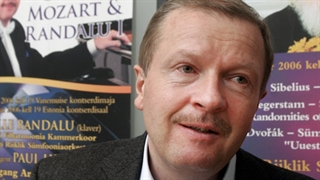Jovial Mozart

Tüür and Mozart at Estonia Concert Hall on September 30. Estonian National Symphony Orchestra (ERSO) conducted by Christoph Poppen, Kalle Randalu (piano).
Somewhere, I am sure that there is a twisted person or persons who don’t like Mozart. But like Beethoven, he is virtually universally loved and that just about guarantees a good time for concertgoers when his music is featured. ERSO’s third program for the season was a heavy dose of Mozart which included a special and rare treat.
Those in attendance Friday were given the opportunity to see the great man’s original manuscript of the solo cadenzas for Piano Concerto No 27 in B flat Major, displayed in the lobby of the concert hall. For some reason it is always interesting to see the hand-writing of great personages, and there is surely no greater personage in the annals of music than Mozart. The manuscript was brought to Estonia by Baltic German Gustav Adolf Hippius 200 years ago and has been stored in the Estonian History Museum for most of that time. The Piano Concerto No 27 would be the second piece performed for the evening, by renowned Estonian Mozart interpreter Kalle Randalu.
First, however, another Estonian took center stage. Erkki-Sven Tüür’s 1997 piece “Lighthouse”, a concert for strings, was a relatively short if effervescent foray into modern composition. It is a wonderful work for those who appreciate the possibilities of cellos and violins working in synergy, in this case bringing to life the imaginative world of Tüür. “Lighthouse” is a layered, complex bit of music that finds its dissonant moments brought right by passages of sublime beauty.
Were I performing brain surgery for the first time, The Piano Concerto No 27 would be the music I would like to be listening to. Serene, yet intense, substantial, yet fluid, the No 27 puts the listener in that good place only Mozart and a few others can manage. With Randalu at the keys of the massive concert piano, a marvelous musical experience ensued and when it was done, he received a hearty congratulation from guest conductor, German Christoph Poppen.
After intermission, came the big event of the evening: Mozart’s Symphony No 41 in C Major, the “Jupiter” symphony. The astounding output of Mozart’s short life should be noted here. The exact number of symphonies he wrote is debatable, but when one considers that Beethoven wrote nine, appreciating No 41 on Friday evening boggles the mind.
The Symphony No 41 is as fine a work of Enlightenment culture as there is. Even an ironic postmodernist like Woody Allen famously offered, “The Symphony No 41 proves the existence of God.”
Whether you’re an atheist, an agnostic or a theist doesn’t matter with Mozart. It’s impossible not be in some sense ennobled and refreshed by the No 41. ERSO, as always performed brilliantly, and the sell-out crowed delighted in every minute of it. Tallinn is very lucky to have such a fine orchestra right in its city center, within easy reach of everybody.
http://news.err.ee/culture/2919bef4-b0a6-42c2-baf5-b8ec15b0ecb3